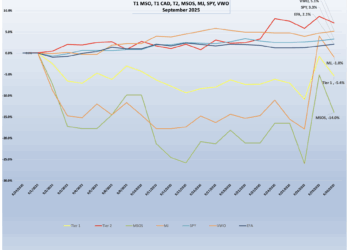The second quarter of 2025 marked another period of retrenchment and consolidation in regulated North American cannabis markets, as established markets continued to shed excess capacity and new markets slowed their growth in the face of market and regulatory headwinds. Overall, growth in the newer balanced contraction in the older, setting the stage for future expansion should any federal actions tilt the risk/reward matrix favorably.
U.S. Highlights
Total active U.S. cannabis business licenses fell 2% to 37,889 in the second quarter, extending a multi-year national decline in licensed operators first evidenced in the fourth quarter of 2022. This quarterly drop suggests a return to trend in the aggregate national market after three quarters of relative stability. Active licenses declined 1% from the previous six-month period, and were 3% lower for the past 12 months. In the past two years total active licenses have declined 13% nationally.
 Approved and pending licenses, which reflect aggregate growth in the country’s 46 regulated cannabis markets, fell sharply in the second quarter, dropping 14% to 4,391, marking the fourth consecutive quarterly decline in new license approvals. The number of new licenses pending activation at the end of June represented an 18% decline from the end of 2024, and a sobering 23% drop from the year-ago period.
Approved and pending licenses, which reflect aggregate growth in the country’s 46 regulated cannabis markets, fell sharply in the second quarter, dropping 14% to 4,391, marking the fourth consecutive quarterly decline in new license approvals. The number of new licenses pending activation at the end of June represented an 18% decline from the end of 2024, and a sobering 23% drop from the year-ago period.
Pre-licensing activity, defined as new license applications pending approval, fell 4% to 5,261, extending a sharp decline that began in the third quarter of 2024 as a flood of applications in New York moved through the review process. Pre-licensing totals were 16% lower than the previous six months, and 22% lower than a year ago, before New York accelerated application processing for its two-year-old adult-use market.
As was the case for the last four quarters, New York dominated pre-licensing activity, accounting for 88% of the new applications in review, with nearly 5,000 applicants awaiting approvals. Despite the activity in the Empire State, the aggregate national pre-licensing total is 40% lower than two years ago, reflecting the sharp change in sentiment in the cannabis markets in the post-epidemic era.
Canada Steady
Active Canadian business licensing counts were steady in the first quarter, adding 1% from first quarter to 5,806 active permits. Active licensing in Canada has remained steady in the 5,800-operator range for the preceding four quarters.
 The recent stability caps a two-year decline of 15% in active Canadian licenses, amplified by the collapse of newly approved and pending licensees. Only two new applicants were approved and pending activation in the second quarter.
The recent stability caps a two-year decline of 15% in active Canadian licenses, amplified by the collapse of newly approved and pending licensees. Only two new applicants were approved and pending activation in the second quarter.
One bright spot in the Canadian market was a 24% surge in new license applications over the previous quarter, to 140. However, the number of applications in review remains 45% lower than a year ago, and 52% lower than two years ago.
Major License Types Flat
Of the major license types, cultivation and retail/dispensary licenses comprise the largest cohort, representing 74% of all active licenses in the U.S. in the second quarter. There were 16,343 active cultivation licenses, a slight decline of 2%, and 11,527 active retail/dispensary licenses, unchanged, at the end of the quarter. Four states: California, Oklahoma, Michigan and Oregon; accounted for 44% of all active cultivation and retail licenses.
 Manufacturer/Processor licenses made up the third largest license type, with 5,338 active licenses at the end of the second quarter, followed by wholesale/distribution licenses, with 1,399, representing 4% and 5% quarterly decreases, respectively, reflecting the relentless ongoing market consolidation in these segments.
Manufacturer/Processor licenses made up the third largest license type, with 5,338 active licenses at the end of the second quarter, followed by wholesale/distribution licenses, with 1,399, representing 4% and 5% quarterly decreases, respectively, reflecting the relentless ongoing market consolidation in these segments.
Vertically integrated operators have shown the greatest growth of all operator types over the past two years, in both rate and number. The number of active vertical operators more than doubled during that period to a high of 2,279 active licensees at the end of the first quarter. So, a slight 4% dip in the second quarter was not unexpected.
Virtually all the new growth in vertical operators has come from New Mexico. Most of this increase was due to a one-time recharacterization by the state’s licensing authorities of existing licensees rather than organic growth. Operators in the state holding multiple licenses were recharacterized as “master” licensees holding sub-licenses for each type of permitted activity they engage in.
Nationally, the category will likely become the third largest operator category for the foreseeable future, as New York works through more than 835 applications for new vertical operations in the Empire State.
Newly Approved Permits Drop
Cannabis business license applications which have been approved but have yet to become operational are grouped by CRB Monitor under the category of “approved/pending” status, and reflect the near-term pipeline of new cannabis business operations poised to enter the regulated market.
 Approved/pending license activity contracted across all major license categories once again in the second quarter. The 15% average decline in Q2 marked the fourth consecutive quarterly drop in new business applications, after peaking in the first half of 2024. In aggregate, newly approved licenses in the major business types fell 20% from levels recorded six months ago.
Approved/pending license activity contracted across all major license categories once again in the second quarter. The 15% average decline in Q2 marked the fourth consecutive quarterly drop in new business applications, after peaking in the first half of 2024. In aggregate, newly approved licenses in the major business types fell 20% from levels recorded six months ago.
Cultivators ended the quarter with 947 approved/pending licenses, a 14% drop from the first quarter, and 35% lower than a year ago. Cultivation permit approval activity has dropped 28% overall in the past two years, reflecting ongoing right-sizing and production consolidation in established markets.
Retail operators ended the quarter with an 8% decline to 2,123 newly approved permits, marking a two-year low in new license approvals. Similar rationalization pressures in established retail markets were muted by license growth in newly opened state markets, primarily from the mid-2024 opening of Ohio’s adult-use market and the ongoing stand-up of retail operators in New York. Nonetheless, overall trends in new licensing activity suggest continued weakness in aggregate.
Licensing approval levels among the other major license types: manufacturer/processors, delivery/transporters, and wholesale/distributors; all declined as well in the second quarter. The sharpest contraction was among pending delivery/transporter licenses, which fell 50% to 207 operators approved and awaiting the commencement of operations at the end of June.
Pending and approved manufacturer/processor license activity declined 16% for the quarter, and is 24% lower than six months ago. Newly approved testing facility licensing declined 10% in the quarter to just 19 new licensed facilities nationwide.
New Applications Decline
Applications for new cannabis business licenses that have yet to be approved are classified as having a “pre-licensing” status at CRB Monitor. While the proportion of these applicants that may succeed in gaining approval, much less opening a cannabis business, is unknown, pre-licensing data nonetheless serves as an indicator of interest in entering or expanding commercial activities in a given market.
 Applications in the pre-licensing phase, which is typically the most volatile licensing phase due to its direct correlation to newly opening and expanding markets, fell 4% in the first quarter to just under 5,261 applications in review. It marked the fourth consecutive quarterly decline, after an early 2024 surge of applications for new adult-use markets in New York, New Jersey and Ohio peaked in the second quarter of 2024.
Applications in the pre-licensing phase, which is typically the most volatile licensing phase due to its direct correlation to newly opening and expanding markets, fell 4% in the first quarter to just under 5,261 applications in review. It marked the fourth consecutive quarterly decline, after an early 2024 surge of applications for new adult-use markets in New York, New Jersey and Ohio peaked in the second quarter of 2024.
Applications in pre-licensing ended June 40% lower than two years ago.Applications in pre-licensing declined across all major license types except delivery/transporters, which rose 7% to 71 applications nationwide. Cultivators once again experienced the sharpest drop, notching a 20% drop for the quarter, while applications for manufacturers and wholesaler/distributors fell by single digits, 8% and 5%, respectively.
Retail/dispensary applications in pre-licensing continued to maintain their post-New York surge levels, ending the quarter with 3,492 in review, a 2% decrease from the previous quarter. As has been the case for more than a year now, applicants in New York comprised the vast majority (95%) of retail operator applicants in review.
New York also dominated licensing applications by vertically-integrated operators, which ended the quarter much as it began, with 849 applications in pre-licensing nationally, of which 835 were seeking New York permits.
Minor License Types Mixed
License types that total less than 300 active licenses nationally are considered minor license types. They include event organizers, management companies, research organizations, social use clubs, storage, waste disposal and, new this quarter, licensed brand companies. In the second quarter none of these minor types totaled more than 80 nationally.
 License activity among the minor types was mixed in the second quarter, with cycle-sensitive event organizers declining 8% in the teeth of a relentless 10-quarter contraction, while newly-introduced social club operators grew 18%. Management company and waste disposal operators each increased slightly, while storage and research licenses were unchanged.
License activity among the minor types was mixed in the second quarter, with cycle-sensitive event organizers declining 8% in the teeth of a relentless 10-quarter contraction, while newly-introduced social club operators grew 18%. Management company and waste disposal operators each increased slightly, while storage and research licenses were unchanged.
For the fourth consecutive quarter social use clubs had the strongest growth among minor types, increasing 18% in the quarter, marking a four-fold increase in the past 12 months to 80 licensed clubs, as California, New Mexico, Nevada, Colorado and Michigan rolled out social consumption formats for their adult-use markets.
Canadian Supply Chain Adjusts
While most licensed sectors of the Canadian cannabis market exhibited continued stability in the first quarter, wholesale/distributors collapsed, losing 44% of its active licensees to 39 active licensees as operators wrestled with the economics of scaling up amid continued margin compression across the market.
 Retail dispensary licenses remained the largest license type with just over 4,100 active permits, a 2% increase. Cultivation and manufacturer/processor licenses remained the second and third largest license types in Canada, each rising 2% during the quarter to 927 and 589, respectively.
Retail dispensary licenses remained the largest license type with just over 4,100 active permits, a 2% increase. Cultivation and manufacturer/processor licenses remained the second and third largest license types in Canada, each rising 2% during the quarter to 927 and 589, respectively.
State Markets Moderate Growth
Licensing in large established state markets was relatively stable in the second quarter, with none of the states with two-year or older markets and at least 500 licensed operators changing more than 6%. Among these established markets – California, Oklahoma, Michigan, Massachusetts, Oregon, Washington, Colorado and Vermont – Massachusetts saw the sharpest decline of 6% of its licensed operators, while California lost the largest number of licensees, 358, a 4% drop. The Golden State has shed 23% of its licensees over the past 24 months, but remains the nation’s largest market in terms of total licensed operators.
 Three years into a moratorium on new licensing and a crackdown on non-compliant operators, Oklahoma shed another 259 licensed cannabis businesses in the second quarter, the second largest absolute decline among the states behind California. The Sooner State’s count of active licensees declined 4% to 5,564, marking a 53% plunge in active licenses over the past eight quarters. Nonetheless the state remains the second largest state market in total active licensed businesses.
Three years into a moratorium on new licensing and a crackdown on non-compliant operators, Oklahoma shed another 259 licensed cannabis businesses in the second quarter, the second largest absolute decline among the states behind California. The Sooner State’s count of active licensees declined 4% to 5,564, marking a 53% plunge in active licenses over the past eight quarters. Nonetheless the state remains the second largest state market in total active licensed businesses.
Michigan reinforced its position as the third largest U.S. market, adding 121 licenses to end the quarter with 4,269, a 3% quarterly increase. The state’s active license counts grew 32% over the past two years, peaking in the third quarter of 2024 at nearly 4,500 licensees.
New York again led the large-population states with both the highest percentage and greatest absolute increase in new licensing, adding 153 new licenses to increase its active count 10% in the quarter, and 158% in the past 12 months, to 1,756 active permits.
New Mexico, which had experienced explosive growth due to a laisse-faire permitting regime that allowed operators to open ahead of inspections and full application review, appears to be slowing as the state’s regulator struggles to get its grip around the other Wild West market bordering prohibitionist Texas. Active licensing declined 5% to 2,891, a drop of 165 licenses.
 Other states with significant percentage increases in active licensing during the quarter include Connecticut, which grew 14%, adding 15 licensees; District of Columbia, which added 43 licensees to double their licensed operators; New Jersey (24, 5%), Ohio (21, 9%), and Pennsylvania (18, 8%).
Other states with significant percentage increases in active licensing during the quarter include Connecticut, which grew 14%, adding 15 licensees; District of Columbia, which added 43 licensees to double their licensed operators; New Jersey (24, 5%), Ohio (21, 9%), and Pennsylvania (18, 8%).
 Overall, 19 of 46 U.S. licensed markets gained licensees in the second quarter, while nine states lost licensees. No state lost more than 7% of its active licenses during the second quarter, and 11 experienced 5% or greater growth. The relatively modest but broad-based growth was a welcome reprieve from what has been a wrenching multi-year retrenchment and rationalization of cannabis markets across the U.S.
Overall, 19 of 46 U.S. licensed markets gained licensees in the second quarter, while nine states lost licensees. No state lost more than 7% of its active licenses during the second quarter, and 11 experienced 5% or greater growth. The relatively modest but broad-based growth was a welcome reprieve from what has been a wrenching multi-year retrenchment and rationalization of cannabis markets across the U.S.
Nevada Leads New Approvals
The approved/pending license status includes those applicants which have received approval to operate but have yet to commence the licensed activity. It is a leading indicator of future growth in the market, as the investment of resources required to prepare, apply for, and successfully obtain a cannabis license suggests a level of commitment that can be used as a proxy for future business activity.
 Approved and pending cannabis license counts increased in four U.S. states: Illinois, Arkansas, Alabama, and Nevada. Only Nevada had a notable absolute increase in newly approved permits, with 24, a 21% rise related to the state’s roll-out of its social use licenses. Approved/pending counts fell by double digits or more in six states, and were down in four others.
Approved and pending cannabis license counts increased in four U.S. states: Illinois, Arkansas, Alabama, and Nevada. Only Nevada had a notable absolute increase in newly approved permits, with 24, a 21% rise related to the state’s roll-out of its social use licenses. Approved/pending counts fell by double digits or more in six states, and were down in four others.
New Jersey once again led the country in the number of approved/pending licenses during the quarter, with 1,493 licenses approved – some years ago – and pending launch in its heavily-regulated adult-use program, a sum more or less unchanged for two years. New York and West Virginia ended the quarter with 684 and 500 new approvals pending activation, respectively. That was an 8% and 13% decrease, respectively, from the earlier quarter.
Massachusetts experienced the greatest fall-off in absolute numbers of approved applications, as new approvals in the second quarter fell by 504 to 219, a 70% decline from the previous quarter.
New York Dominates New Applications
Applications for new cannabis business licenses, which reflect activity and sentiment in newer and expanding markets, were weaker across markets in the first quarter. Only nine states recorded any application activity at all, and each had less submissions than Q1.
 New York led the quarter once again with the largest number of applications in pre-licensing, with 4,696 permits in application, essentially unchanged from before. The number of licenses in application in New York accounted for 89% of all license applications pending approval in the U.S. at the end of June.
New York led the quarter once again with the largest number of applications in pre-licensing, with 4,696 permits in application, essentially unchanged from before. The number of licenses in application in New York accounted for 89% of all license applications pending approval in the U.S. at the end of June.
Massachusetts was a distant second to New York, with 228 applications in pre-approval status, a 5% decrease from the prior quarter. District of Columbia recorded 92 applications for its licensed retailer program, a 32% decline, while Arkansas, Maine, Connecticut and Nevada all recorded a few dozen application submissions in the quarter.
Established cannabis powerhouse California recorded only seven new license applications in processing at the end of June, a situation unchanged for the third consecutive quarter.
Summary
The second quarter of 2025 was characterized by continued market consolidation and retrenchment across North American cannabis sectors, as evidenced by a multi-year 13% decline in total active U.S. licenses and a fourth consecutive quarterly drop in the pipeline of approved/pending new licenses.
While the Canadian market demonstrated relative stability, U.S. activity was marked by significant contrasts: established markets like California and Oklahoma rationalized capacity, whereas emerging markets, particularly New York—which accounted for a dominant 88% of all new U.S. applications—drove growth.
The standout performer was the vertically integrated operator category, which more than doubled over the past two years, though this was largely attributable to regulatory reclassification in New Mexico.
Overall, the data indicates a mature industry prioritizing efficiency and scale over expansion, with nascent growth niches like social use clubs representing a notable, though still minor, bright spot amidst broader contraction.
Click here to download a PDF version of this report.













